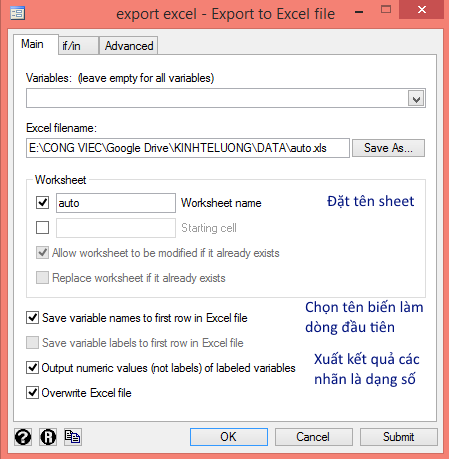

Import excel stata 12 series#
# Set variable equal to time series data: strain Datasets can be hundreds of gigabytes or terabytes.Standard for storing large quantities of numerical data.# Plot histogram of one column of the DataFrame # Load Stata file into a pandas DataFrame: df # Plot histogram of DataFrame features (pandas and pyplot already imported) With SAS7BDAT( 'sales.sas7bdat') as file: Note that the arguments all need to be of list type With open( 'pickled_fruit.pkl', 'rb') as file: # 'rb' = read, binary (computer readable)ĭf1 = data.parse( '1960-1966') #sheet nameĭf2 = data.parse( 0) #sheet index, as a float Pickled files are serialized = convert object to bytestream.
Import excel stata 12 how to#

1ĭata_array = data.values # Build a numpy array from the DataFrameĬomment= '#', #takes characters that comments occur after in the file It’s now standard and best practice to use pandas to import flat files. We need DataFrame.ĭataFrame = pythonic analog of R’s data frame. To have two-dimensional labeled data structure(s) with columns of potentially different types, to be able to manipulate, slice, reshape, groupby, join, merge, perform statistcis, work with time series data…. Recfromcsv() has the defaults delimiter = ',' and names = True in addition to dtype = None Pandas Because numpy arrays have to contain elements that are all the same type, the structured array solves this by being a 1D array, where each element of the array is a row of the flat file imported. We can use genfromtxt() to handle such structures.ĭtype = None) #figure out what types each column should be by itselfīecause the data are of different types, data is an object called a structured array. Loadtxt() is not that useful when we have mixed datatype in a dataset. Usecols = ) # only use the first and the third columns Skiprows = 1, # skip the first row, which is the header We can use loadtxt() and genformtxt() to load data into NumPy. NumPy arrays are standard for storing numerical data, and is essential for other packages like scikit-learn. txt: text file(separated by characters or sequence of characters other than commas, such as a tab.

Note whether the file has a header is important when importing the data. Each record means a row of fields or attributes. This in contrast with relational database, in which columns of distinct tables can be related. Or the following:įlat files are basic text files containing records, which is table data without structured relationships. !ls will display the contents of your current directory. Starting a line with ! gives you complete system shell access.

With open( 'huck_finn.txt', 'r') as file: That’s also why with is called a Context Manager. Once out of this context, the file is no longer open. This will allow you to create a context in which you can execute your command with the file open. To avoid having a closing connection to the file by using a with statement. To read a plain text file, we can use Python’s basic open function to open a connection to the fileįile = open(filename, mode = 'r') # 'r' = read, to make sure we are only reading it, not writing it or sth else.įile.close() # make sure you close the connection after saving it to a variableįile = open(filename, mode = 'w') # 'w' = write Datacamp course notes on importing data from various sources of various types.


 0 kommentar(er)
0 kommentar(er)
